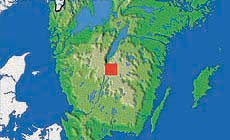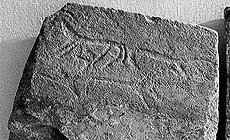|
|
 |
 |
Country: |
Sweden |
Locality: |
Sagaholm |
|
 |
Region: |
Småland |
Area: |
Ljungarum |
|
 |
 |
|
|
|
|
| |
 |
Environment & Surface |
 |
 |
 |
|
Open-air
Shelter
Cave
Portable
Megalithic
|
Geography: |
The barrow of Sagaholm was severely damaged, parts had been cut away, and the engrave slabs have been removed after documentation. The original position was at the edge of wood, 30 m S of farm-house. |
Proximity: |
Lake Vättern and the city of Jönköping. |
|
 |
Geology: |
Sandstone |
Surface: |
18 carved slabs |
|
|
|
|
 |
 |
|
|
|
|
| |
 |
Art |
 |
 |
 |
Description: |
Engravings
Paintings
Painted engravings
High or low-relief
Sculpture
The barrow of Sagaholm. Nothing remains of the once so magnificent barrow, written records speak about a diameter of c. 22 m and about 2.5 m high, even when severely damaged. The archaeological investigation showed that the barrow consisted of turf from sandy soil, and the contours from decomposed turf were visible in the sand under the barrow. Along the edge of the barrow there was a stratified mixed layer of earth and stones of varying sizes, 0.05-0.6 m. Under this layer there were 2 rows of kerb-stones. The inner kerb-stones consisted of slabs of sandstone, placed edgeways leaning, turned outside. The slabs were cut and had been dug into the ground, 0.25 - 0.85 m wide and 0.4 - 1 m high.
On the outer sides of the slabs rock carvings were depicted. There are 18 remaining slabs with carvings, arranged in a certain way. There are a number of ship figures with totally carved out hulls, some with crew lines placed in pairs on the gunwale. There are a number of animals, the majority depicting stylised horses, and also other kinds of animals, possibly a buck. On slab no 13, a previously not known horse figure was discovered in 1997, during a re-documentation of the slabs (Goldhahn 1999:59). There is also an unusual scene depicted, showing a human figure having sexual intercourse with an animal. This motif is known from Bohuslän (Kallsängen) and also from Valcamonica. Most of the animals seem to be horses. Another scene is showing a human figure equipped with bow and arrow, and an animal of some kind. The motif is quite unusual, but similar scenes are known from Bohuslän, and also Östergötland. The most common technique used is pecking technique, but also carved with a tool made of metal or flint. Some of the slabs have been grinded after the pecking.
|
Figures: |
Ship figures
Animal figures/horses
Human figures
Cup marks
Weapon/bow and arrow/sword
Obscure figures
|
|
 |
Chronology: |
Palaeolithic
Epipalaeolithic - Mesolithic
Neolithic
Copper Age
Bronze Age
Iron Age
Roman
Middle Age
Modern
Unknown
The barrow of Sagaholm belongs to the Early Bronze Age, and have been C-14 dated to c. 1450 BC. The find is of vital importance for the dating of the South Scandinavian rock carvings.
|
Notes: |
The rock carvings of the Sagaholm barrow have been interpreted in various ways, the find is of vital importance for the dating of the South Scandinavian rock carvings. Special concern has been given to the frequent horse motif at Sagaholm, and it has been argued by some scholars that they and the morphology of this particular barrow can be seen as a metaphor for a new and exotic cosmology that reached Scandinavia during the Early Bronze Age (Goldhahn 1999). |
|
 |
 |
|
| |
 |
Bibliography |
 |
|
|
|
|
| |
 |
Conservation |
 |
 |
 |
Status: |
Public
Private
Park
Classified site
|
Risk: |
The carved slabs are made of sandstone, a quite porous material and subject to weathering. |
|
 |
Conservation: |
Good
Quite good
Mediocre
Bad
|
Intervention: |
The decorated slabs of The Barrow of Sagaholm are situated in Jönköpings Läns Museum (JLM), and subject to continuous controls. |
|
 |
 |
|
|
 |
By |
 |
|
| |
| Record n. 771 / 807 |
No commercial use is allowed. Specific © is mentioned in the captions or owned by each Author or Institution |
|
| |
 |
EuroPreArt, European Prehistoric Art, is a web-based archaeological project funded by the European Union which aims to establish a lasting data-base of European prehistoric art documentation, to launch the base of an European institutional network and to contribute to the awareness of the diversity and richness of European Prehistoric Art.
It is proposed by: Instituto Politécnico de Tomar (IPT, Portugal),
CUEBC - European University Centre for Cultural Heritage (Italy - Europe),
Consejo Superior de Investigaciones Científicas (España),
Asociación Cultural Colectivo Barbaón (España),
Université de Liège (Belgique),
Gotland University College (Sverige),
University College Dublin (Eire),
Cooperativa Archeologica Le Orme dell'Uomo (Italia),
Study Centre and Museum of Prehistoric Art of
Pinerolo (Italia),
The European Centre for Prehistoric Research in the Alto Ribatejo (Portugal),
ArqueoJovem - a youth NGO (Portugal).
|
|
|
|
 |
|
 NEW: Alpine rock paintings
NEW: Alpine rock paintings





